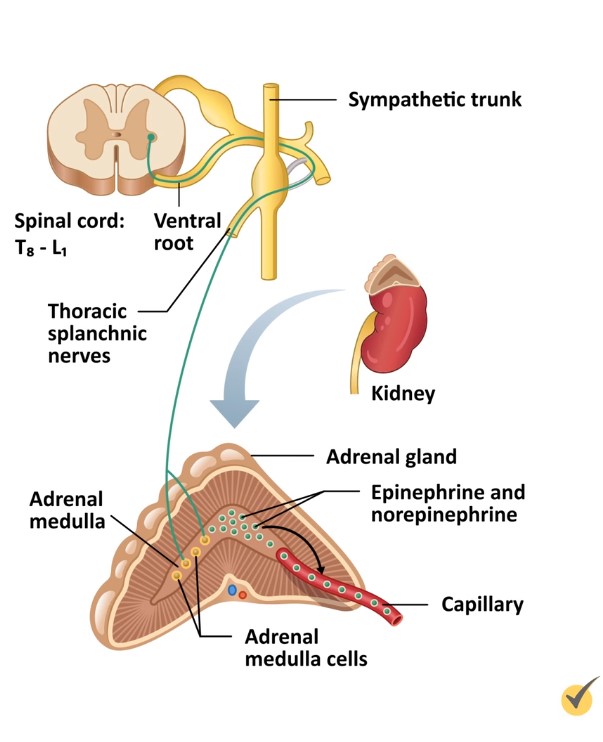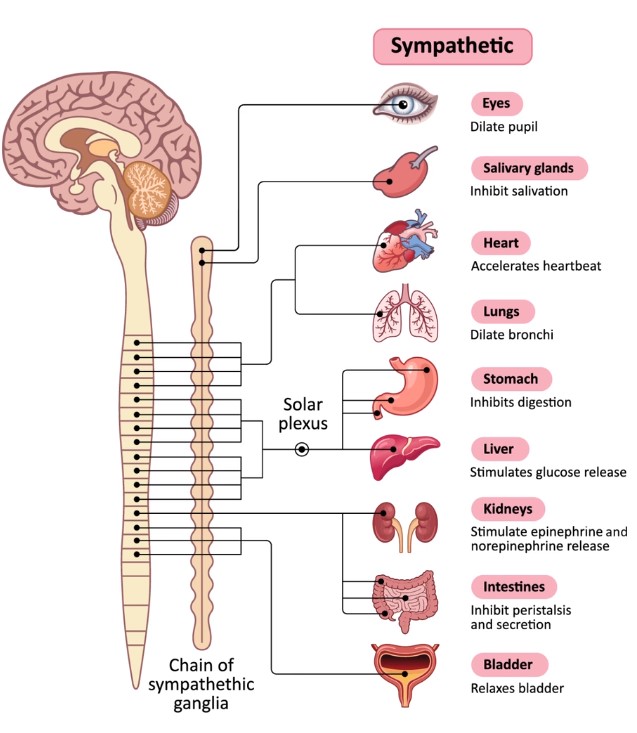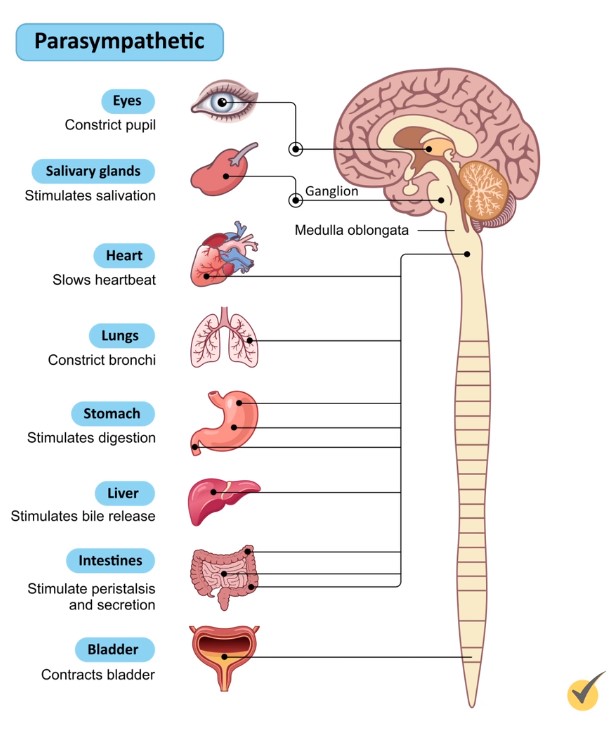
Welcome to this video about the autonomic nervous system. The nervous system comprises two subsystems:
First, the central nervous system (which includes only the brain and spinal cord).
Second, the peripheral nervous system, which includes all of the neurons outside of the central nervous system and is divided into two parts, the somatic nervous system (which includes the sensory nervous system and the motor nervous system) and the autonomic nervous system.
Autonomic Nervous System
The autonomic nervous system controls involuntary processes, such as the heartbeat and respirations, and consists of three separate divisions:
- Sympathetic nervous system
- Parasympathetic nervous system
- Enteric nervous system
These systems that comprise the autonomic nervous system interact because many organs have nerve fibers from each of the divisions. One division, for example, may activate a response, while another may inhibit a response.
All neurons in the autonomic nervous system are efferent, or motor, neurons and their primary function is to maintain the body’s homeostasis through innervation of tissues, such as organs, glands, and blood vessels, and various systems, including the
- Cardiovascular system
- Gastrointestinal system
- Respiratory system
- Urinary system AND
- Integumentary system.

Typically, a two-neuron structure is found in the autonomic nervous system. That is, the preganglionic neuron has its cell body in the central nervous system and its axon in an autonomic ganglion where it synapses with one or more postganglionic neurons. The postganglionic neurons have their cell bodies in the autonomic ganglion, and their axons travel to the tissues that they innervate.

There are some exceptions to the two-neuron structure. For example, the preganglionic neurons pass through ganglia and synapse directly with the medulla tissue in the adrenal glands to stimulate production of epinephrine and norepinephrine.

Some of the primary functions of the autonomic nervous system are the regulation of
- Blood pressure and pulse
- Body temperature
- Fluid and electrolyte balance
- Metabolism
- Reproduction
- Digestion
Sympathetic Nervous System
Let’s look first at the sympathetic nervous system. The neurons of the sympathetic nervous system arise in the thoracic and lumbar areas of the spinal cord (T1 to L2).
The sympathetic nervous system activates the “fight or flight” response in the body, and the body goes into a protective mode:
- The bladder contracts, the eyes dilate, and the heartbeat increases
- Peristalsis and intestinal motility decrease to save energy
- The kidneys secrete less urine and stimulate the release of norepinephrine and epinephrine
- The liver releases glucose to increase energy
- The bronchi in the lungs dilate to increase the oxygen supply
- The mouth becomes dry from decreased salivation, and digestion is inhibited

The preganglionic neurons of the sympathetic nervous system secrete the neurotransmitter acetylcholine and are, therefore, considered cholinergic. Most of the postganglionic neurons, however, secrete norepinephrine and are, therefore, adrenergic.
Usually, with a sympathetic response, the blood vessels constrict except for the coronary vessels and vessels supplying skeletal muscles and the external genitalia. However, with coronary artery disease, the coronary vessels may constrict.
The production of epinephrine and norepinephrine by the adrenal glands is activated by stress and is, therefore, under control of the sympathetic nervous system. While stress response is controlled by the sympathetic nervous system, normal everyday processes are as well.
For example, the sympathetic nervous system opens the airways with every breath to facilitate the inspiration of air into the lungs. Additionally, the diameter of most blood vessels is under almost complete control of the sympathetic nervous system so that vessels are in a constant state of partial constriction.
When sympathetic impulses decrease, the vessels dilate; when impulses increase, they constrict.
Parasympathetic Nervous System
Now, let’s look at the parasympathetic nervous system.
The neurons for the parasympathetic nervous system arise in the midbrain, pons, and medulla oblongata of the brain stem, and in the sacral area of the spine (S2 to S4). The vagus nerve carries about 75% of parasympathetic nerve fibers.
The preganglionic neurons of the parasympathetic nervous system, like in the sympathetic nervous system, secrete acetylcholine and are cholinergic. However, unlike the sympathetic nervous system in which postganglionic neurons are adrenergic, most postganglionic neurons of the parasympathetic nervous system are cholinergic like their preganglionic counterparts.
So, while the sympathetic nervous system is both cholinergic and adrenergic, the parasympathetic nervous system is almost completely cholinergic with a few exceptions, such as those neurons that utilize nitric acid as a neurotransmitter (which is adrenergic).
The parasympathetic nervous system maintains the body systems in their normal state:
- The bladder relaxes.
- The pupils constrict.
- The heartbeat slows.
- Peristalsis and intestinal motility increase.
- The kidneys increase the secretion of urine.
- The liver releases bile.
- The bronchi in the lungs constrict.
- Salivation increases.
- Digestion is stimulated.
Additionally, parasympathetic impulses use nitric acid to relax the smooth muscles in the penis and clitoris, resulting in erection, and increase gland secretion during sexual arousal, while sympathetic impulses inhibit sexual arousal.

Enteric Nervous System
The enteric nervous system, which comprises a web-like structure of neural circuits, regulates digestion with neurons embedded in the entire length of the gastrointestinal system, from the esophagus to the anus.
The enteric system can function independently, but can also be influenced by the sympathetic and parasympathetic nervous systems.
The enteric nervous system controls gastrointestinal motor functions, fluid and electrolyte exchange, local blood flow, and the production of gastric and pancreatic secretions in the gastrointestinal system.
Because of its ability to function independently of the central nervous system, the enteric nervous system is sometimes referred to as the “second brain” of the body.

There are many disorders associated with the autonomic nervous system. Some of these disorders occur as a secondary effect of another disorder.
For example, autonomic neuropathy or dysautonomia, a condition with impairment of nerves that control involuntary processes, is often associated with diabetes mellitus or alcoholism but may also occur with a number of different disorders, including Parkinson’s disease, HIV/AIDS, Lyme disease, and nutritional deficiencies. Symptoms may vary widely depending on which nerves are most affected, but may include postural hypotension, sexual dysfunction, gastrointestinal dysfunction, and urinary dysfunction.
Other disorders include multiple system atrophy, postural orthostatic tachycardia, Horner syndrome, and Triple A syndrome.
Multiple system atrophy is a rapidly progressive neurological degenerative disease of the autonomic nervous system for which there is no cure. Multiple system atrophy usually includes postural hypotension and other symptoms associated with impaired autonomic function, including sexual dysfunction, GI dysfunction, and urinary dysfunction. There are two types of multiple system atrophy. The Parkinsonian type is characterized by symptoms similar to Parkinson’s disease, such as muscle rigidity, bradykinesia, and tremors. The cerebellar type is characterized by ataxia and may include dysarthria and dysphagia as well as visual disturbances.
Postural orthostatic tachycardia is another disorder that is sometimes associated with overactivity of the sympathetic nervous system.
People with this disorder experience a rapid increase in heart rate of greater than 30 beats a minute or an overall rate of greater than 120 beats per minute and lightheadedness with hypotension within 10 minutes of rising from a supine position. This disorder is most common in females between the ages of 15 and 50.
Horner syndrome may be a congenital or acquired disorder and results from impairment of cervical sympathetic nerves, which control some functions of the face and eyes. Typically, an eye and one side of the face is affected. The affected eye exhibits ptosis (or drooping of the upper eyelid) and pupil constriction, and sweating is absent on that side of the face. Vision is usually not impaired.
Triple A syndrome is an inherited disorder associated with impairment of the autonomic nervous system. Triple A syndrome is characterized by achalasia (which is impaired functioning of the esophagus), Addison’s disease, and alacrima (reduced or absent production of tears). Many of the symptoms associated with this disorder relate to dysfunction of the autonomic nervous system, including impaired thermoregulation, unequal pupils, sweating abnormalities, labile blood pressure, and impaired digestion. In addition, this disorder may include multiple neurological abnormalities, such as impaired cognition, dysarthria, microcephaly, movement disorders, and peripheral neuropathy.
In conclusion, remember that the autonomic nervous system is a part of the peripheral nervous system and has three components: the sympathetic nervous system, the parasympathetic nervous system, and the enteric nervous system.
The autonomic nervous system is critical to the functioning of the body, as it controls the automatic processes that are necessary to support life.
That’s all for this review. Thanks for watching, and happy studying!
